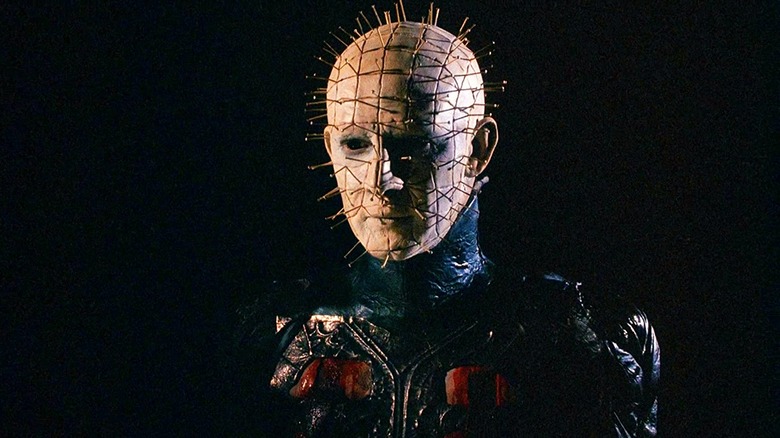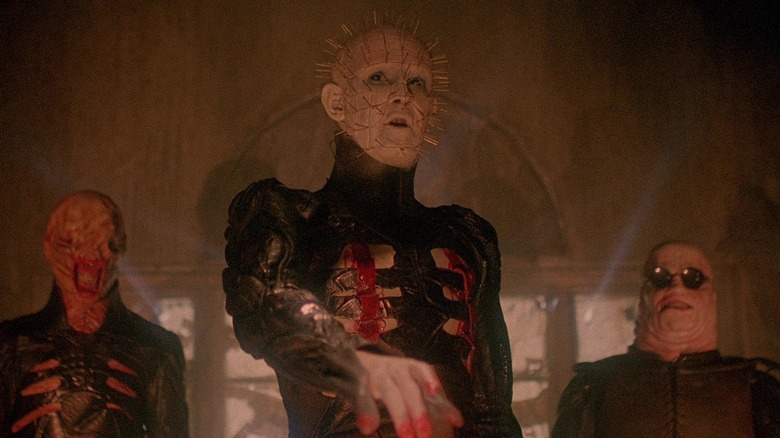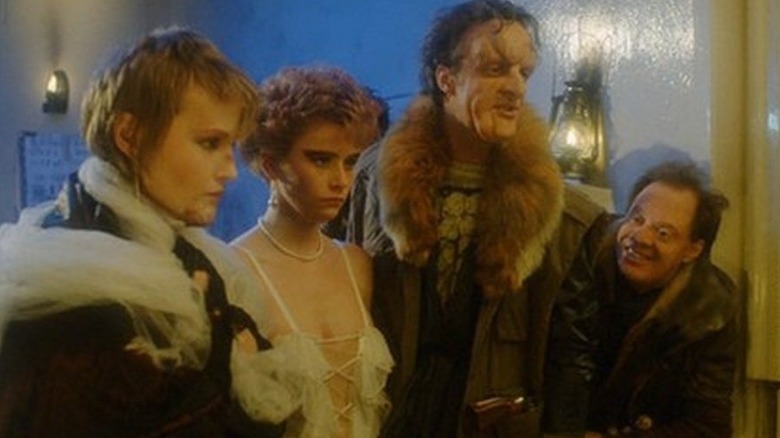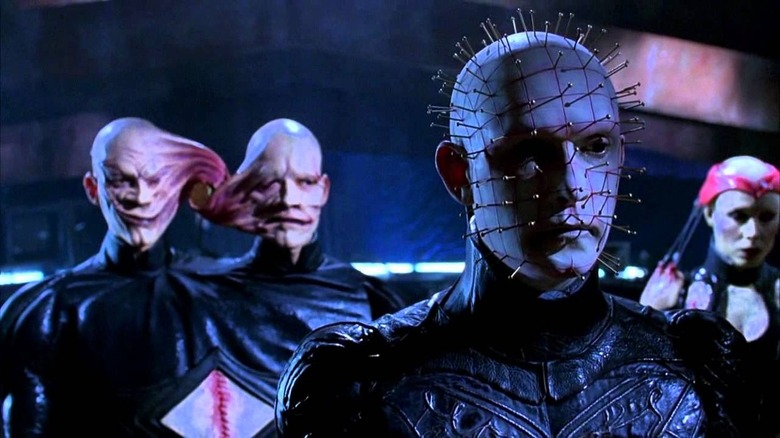The Wild Origins Of Pinhead's Design
The character now known as Pinhead first appeared in Clive Barker's 1986 novel "The Hellbound Heart," as merely one of a small group of supernatural sadomasochists from beyond the grave. A character named Frank, a sexual hedonist on a mad search for the ultimate sensual experience, solves a mystical puzzle box that magically summons threatening, leather-clad beings called Cenobites. The Cenobites have long since shed their humanity in devotion to S&M-inflected sensory overload which requires their bodies to be in a constant state of mutilation. The Pinhead Cenobite, not expressly male or female, was described thus:
"Its voice, unlike that of its companion, was light and breathy — the voice of an excited girl. Every inch of its head had been tattooed with an intricate grid, and at every intersection of horizontal and vertical axes a jeweled pin driven through to the bone. Its tongue was similarly decorated."
When Barker adapted "The Hellbound Heart" to film "Hellraiser" in 1987, the Cenobite decorated with jeweled pins became expressly male and was played by actor Doug Bradley. The character was credited merely as "Lead Cenobite," and shared the screen with Cenobites described as "Chatterer," "Butterball," and simply "Female Cenobite." Bradley's character wasn't called "Pinhead" until the credits of "Hellbound: Hellraiser II" in 1988. Since the release of those two movies, Pinhead has taken hold in the popular consciousness as one of the most striking movie monsters in horror history.
Bradley would go on to play Pinhead in six additional "Hellraiser" sequels. In "Hellraiser: Revelations," the character would be played by Stephan Smith Collins. In "Hellraiser: Judgment," the character would be played by Paul T. Taylor. In the new reboot of "Hellraiser," Pinhead is played by Jamie Clayton.
The origins of Pinhead
The design of Pinhead reaches back further than Clive Barker's source material, however. While "Hellraiser" remains Barker's first feature film as a director, throughout the 1970s, Barker was involved in multiple experimental theater projects and directed a few experimental short films. Briefly, in 1976 and 1977, Barker wrote "A Clown's Sodom" and "The Day of the Dog," his first plays as a solo playwright. The following year, Barker would co-found a theater troupe called The Dog Company where Barker would first meet Bradley and Peter Atkins, the screenwriter for the first few "Hellraiser" sequels. It was with The Dog Company that Barker would direct some of his better-known plays, including "Frankenstein in Love," "The Secret Life of Cartoons," and "The History of the Devil."
Barker first experimented with film way back in 1973 with a brief experimental short based on the ancient play "Salome," and would return to the medium in 1978 with a short called "The Forbidden," based on a short story from Barker's own horror anthology "The Books of Blood." Running 36 minutes in length, lacking dialogue, and shot in high-contrast black-and-white, "The Forbidden" is about a man who is apprehended and transformed into an art project wherein his skin is slowly removed. Periodically throughout "The Forbidden," Barker would cut to a small board festooned with a grid, and at every intersection of horizontal and vertical axes, a nail was driven.
In a 1995 interview included on the DVD of "The Forbidden," Bradley recalled Barker experimenting with multiple similar "nail boards" earlier in his artistic career and could see the direct corollary between decorating a board with a grid of nails ... and decorating a human face with a grid of pins.
Underworld
Also prior to the writing of "The Hellbound Heart" was a lesser-known film project called "Underworld," directed by George Pavlou and penned by Barker. The admittedly shlocky British production starred Denholm Elliot as a mad doctor who was, through the use of bizarre drugs, creating his own race of underground mutants. The mutants lived in the London Underground, and would eventually get their revenge on their creator, but not before a lot of monster mayhem.
In a 1987 issue of the alternative news magazine Nexus, handily archived on Barker's own website, Barker recalled how disappointed he was with "Underworld," and how the producers took away his screenplay and added car chases and nudity. The producers also murdered off different characters than Barker intended, messing with his structure. He said that:
"There were seven of my lines left; they even killed different people. One thing I'm proud of: I plot well, I plot tightly. If a character appears on page three he has a purpose on page ninety-three, otherwise he isn't on page three. So it's really irritating when they kill a different villain."
Barker recalls his original ending to "Underworld" which would have involved the mad doctor being murdered by his own mutant creations. The way in which the doctor was dispatched recalled a specific nail board that Barker had once worked on that, he acknowledged, would inspire the look of Pinhead. He said:
"He was forced by the monsters to take some of his own drug — he was a doctor, and all the way through we'd seen him using hypodermics on people. These pricks appeared on his face one by one and hypodermics pushed through so his face became a mass of needles — an image I finally used in 'Hellraiser,' of course."
The fate of Pinhead
Barker has notoriously had a difficult time getting his projects off the ground. He was once poised to adapt his series of young adult novels "Abarat" into an epic multimedia project for Disney, but that fell through. Barker's work tends to be oblique, strange, and incredibly bloody. As such, many film producers balk at his work. It should perhaps be a lesson that when he was allowed to make a horror movie, it became a decades-long horror franchise.
Eventually, Pinhead would be killed off in a high-tech sci-fi sequence in the 1996 film "Hellraiser: Bloodline." A descendant of the inventor of the notorious Cenobite-summoning puzzle box would — many centuries in the future — create a space-bound anti-box, meant to destroy demonic evil. Cenobites would be let loose on a satellite before being enclosed and destroyed in a massive technical superstructure. Pinhead's last word was "Amen." It's not as bad as it sounds. Pinhead would also return in multiple sequels thereafter, so his death in the distant future was hardly an issue.
Pinhead had become too striking and too popular to kill off, and his persistence in the popular consciousness is a testament to Barker's persistence of vision. An idea Barker had as a youth kept circling in his mind until it manifested as one of horror's more notorious monsters.



